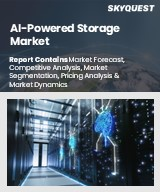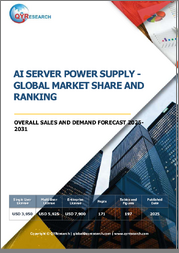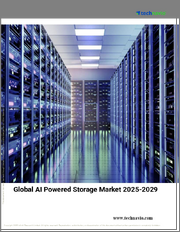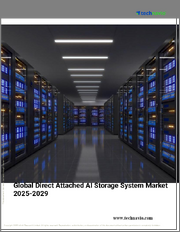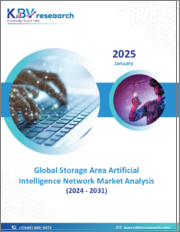
|
시장보고서
상품코드
1725056
AI 기반 스토리지 시장 예측(-2032년) : 제공, 솔루션 유형, 스토리지 시스템, 스토리지 아키텍처, 전개 모델, 스토리지 매체, 최종사용자, 지역별 세계 분석AI Powered Storage Market Forecasts to 2032 - Global Analysis By Offering, Solution Type, Storage System, Storage Architecture, Deployment Model, Storage Medium, End User and By Geography |
||||||
Stratistics MRC에 따르면, 세계 AI 기반 스토리지 시장은 2025년 347억 1,000만 달러로 예측 기간 동안 23.2%의 CAGR로 성장하여 2032년에는 1,495억 1,000만 달러에 달할 것으로 예상됩니다. 인공지능을 사용하여 관리, 성능, 효율성을 개선하는 시스템을 AI 기반 스토리지라고 합니다. 이러한 스마트 시스템은 머신러닝 알고리즘과 예측 분석을 통해 용량 예측, 이상 감지, 데이터 계층화, 성능 튜닝 등의 프로세스를 자동화합니다. 인공지능(AI)이 탑재된 스토리지는 사용 동향과 애플리케이션 수요를 지속적으로 평가하여 데이터 보안을 향상시키고, 지연 시간을 줄이며, 리소스를 동적으로 할당합니다. 이는 특히 대량의 비정형 데이터를 다루는 기업에게 보다 빠르고 경제적인 스토리지 솔루션으로 이어집니다. 또한, AI 기반 스토리지는 디지털 전환이 가속화됨에 따라 효율적인 확장 및 데이터에 기반한 의사결정을 위해 AI 기반 스토리지가 필수적인 요소로 자리 잡고 있습니다.
IDC(International Data Corporation)에 따르면, AI, IoT, 엣지 컴퓨팅의 채택 확대로 인해 2025년까지 전 세계 데이터 영역은 175제타바이트 규모로 성장할 것으로 예상됩니다. 이러한 성장에 따라 데이터를 효율적으로 관리하고 분석하기 위해서는 AI 기반 스토리지를 포함한 첨단 스토리지 솔루션이 필요합니다.
고속 데이터 액세스에 대한 수요
AI 및 머신러닝 애플리케이션의 고빈도 분석, 실시간 추론, 모델 학습을 위해서는 빠른 데이터 액세스가 필수적이며, 기존 스토리지 인프라는 제한된 IOPS(초당 입출력 처리 횟수)와 지연 시간으로 인해 병목 현상이 발생할 수 있습니다. AI 기반 스토리지 솔루션은 NVMe, 올플래시 어레이, 인텔리전트 캐싱 알고리즘 등의 기술을 활용하여 초저지연과 높은 처리량을 제공합니다. 또한, AI 엔진으로의 원활한 데이터 전송을 보장하여 워크로드 실행 속도를 크게 향상시키고, 금융 모델링, 의료 진단, 무인 자동차 등 다양한 산업에서 전체 애플리케이션의 성능을 향상시킬 수 있습니다.
높은 운영 및 도입 비용
AI 기반 스토리지 시스템은 전용 소프트웨어, 하드웨어, 훈련된 직원 등 많은 초기 투자가 필요합니다. 스토리지 클래스 메모리, NVMe, 올플래시 어레이와 같은 기술은 고성능에도 불구하고 기존 HDD 기반 시스템보다 가격이 비싸고, AI 알고리즘을 스토리지 워크플로우에 통합하려면 GPU 및 고성능 CPU와 같은 고급 컴퓨팅 리소스가 필요하기 때문에 비용이 더욱 증가합니다. 컴퓨팅 리소스가 필요하기 때문에 비용은 더욱 증가합니다. 이러한 비용은 많은 중소기업에게 부담스러울 수 있으며, 도입이 제한될 수 밖에 없습니다. 또한, 스토리지 시스템이 최상의 상태로 작동하도록 하기 위해서는 잦은 업데이트, 모델 교육 및 유지보수가 필요하기 때문에 운영 비용도 증가합니다.
지능형 데이터 관리에 대한 기업의 요구가 증가하고 있습니다.
각 산업 분야에서 디지털 전환이 빠르게 진행되면서 기업들은 전례 없는 규모의 데이터를 생성하고 수집하고 있습니다. AI 기반 스토리지는 지능형 계층화, 예측 분석, 자동 데이터 분류, 자가 복구 메커니즘 등의 기능을 제공하여 비즈니스 연속성을 향상시키고, 보다 지능적인 의사결정을 가능하게 하는 AI 기반 스토리지에 대한 수요가 증가하고 있습니다. 의사결정을 가능하게 합니다. 또한, 데이터의 전략적 가치를 인식하는 기업이 늘어남에 따라 데이터의 유용성을 최적화할 수 있는 지능형 스토리지 솔루션에 대한 수요는 점점 더 높아질 것으로 보입니다.
기술의 급속한 노후화
AI와 스토리지 기술의 급속한 발전으로 기존 솔루션은 곧 구식이 될 수 있습니다. 현재의 AI 기반 스토리지 시스템은 새로운 아키텍처, 스토리지 프로토콜 또는 AI 하드웨어의 발전(양자 컴퓨팅, 뉴로모픽 칩 등)에 의해 빠르게 추월당할 수 있습니다. 또한, 오늘날의 솔루션에 많은 투자를 하는 기업들은 더 효과적이고 새로운 대안이 곧 등장할 경우 뒤처질 위험이 있습니다. 이러한 환경의 변화로 인해 잠재적인 도입 기업들은 망설이고 있으며, 특히 시스템 수명과 장기적인 ROI를 우려하는 기업들은 주저하고 있습니다.
COVID-19의 영향:
COVID-19 팬데믹은 AI 기반 스토리지 시장에 다양한 영향을 미쳤습니다. 한편으로는 공급망 중단과 IT 투자 연기로 인해 초기 팬데믹 확산과 하드웨어 가용성이 일시적으로 둔화되었습니다. 그러나 이 위기는 많은 산업에서 디지털 전환을 가속화시켰고, 기업들은 증가하는 데이터를 처리하고 비즈니스 연속성을 보장하기 위해 클라우드 서비스, AI 기반 분석, 원격 운영으로 빠르게 전환했습니다. 또한, 데이터 증가로 인해 AI 워크로드를 처리할 수 있는 확장성이 뛰어난 지능형 스토리지 시스템의 필요성이 대두되고 있습니다. 이에 따라 헬스케어, E-Commerce, 금융 등의 산업을 중심으로 AI 기반 스토리지 솔루션에 대한 관심과 자금 조달이 증가하고 있습니다.
예측 기간 동안 AI 통합 소프트웨어 분야가 가장 큰 시장으로 성장할 전망
AI 통합 소프트웨어 분야는 예측 기간 동안 가장 큰 시장 점유율을 차지할 것으로 예상됩니다. 이 분야의 목적은 스토리지 시스템에 인공지능을 통합하여 데이터 관리 및 운영 효율성을 향상시키는 것입니다. AI 통합은 지능형 데이터 검색, 실시간 분석, 예측 유지보수, 자동 데이터 분류를 가능하게함으로써 스토리지 효율성을 높이고 운영 비용을 절감할 수 있습니다. 또한, 스토리지 시스템과 다른 비즈니스 애플리케이션을 원활하게 통합하여 보다 지능적이고 유연한 인프라를 구현할 수 있으며, AI 강화 기술에 대한 수요 증가와 보다 지능적이고 효율적인 스토리지 시스템에 대한 요구가 업계 전반의 성장을 견인하고 있습니다. 이 부문의 성장을 주도하고 있습니다.
예측 기간 동안 스토리지 영역 네트워크(SAN) 부문이 가장 높은 CAGR을 기록할 것으로 예상됩니다.
예측 기간 동안 SAN(Storage Area Network) 분야가 가장 높은 성장률을 보일 것으로 예상되며, SAN 시스템은 재해 복구 및 빅데이터 분석과 같은 엔터프라이즈급 애플리케이션에 적합한 고속, 저지연 데이터 액세스를 제공합니다. 적합합니다. 유연성과 확장성이 뛰어나 기업들은 지속적인 업무에 지장을 주지 않고 스토리지 용량을 늘릴 수 있습니다. 강력한 성능과 향상된 데이터 보안으로 인해 SAN 솔루션은 헬스케어, BFSI 등의 분야에서 특히 선호되고 있습니다. 또한, AI 기반 스토리지 시장에서 SAN이 빠르게 부상하고 있는 것은 까다로운 워크로드와 복잡한 데이터 환경을 관리할 수 있는 능력을 반영하여 SAN이 널리 사용되고 있는 결과입니다.
가장 큰 점유율을 차지하는 지역
예측 기간 동안 유럽 지역이 가장 큰 시장 점유율을 차지할 것으로 예상됩니다. 이 지역은 제조, 헬스케어, 금융 등 다양한 분야에서 AI 기술 활용이 확대되면서 빠르게 성장하고 있습니다. 클라우드 기반 스토리지와 AI 인프라에 대한 투자로 프랑스, 독일, 영국 등의 국가들이 표준을 정립하고 있습니다. 또한, 유럽연합(EU)이 디지털 전환을 강조하고 일반 데이터 보호 규정(GDPR)과 같은 법적 프레임워크를 마련한 결과, 안전하고 효과적인 AI 기반 스토리지 솔루션에 대한 수요도 증가하고 있습니다. 또한, AI 기반 스토리지 시장에서 유럽의 시장 점유율은 클라우드 컴퓨팅과 인공지능의 발전뿐만 아니라 데이터 분석에 대한 수요 증가에 의해 주도되고 있습니다.
CAGR이 가장 높은 지역:
예측 기간 동안 아시아태평양이 가장 높은 CAGR을 보일 것으로 예상됩니다. 많은 산업 분야에서 로봇 공학의 광범위한 사용, 클라우드 기반 서비스에 대한 수요 증가, 실시간 데이터 처리에 대한 요구 증가가 이러한 급격한 확장의 주요 요인으로 작용하고 있습니다. 또한, 이러한 확장의 주요 국가는 중국, 일본, 인도입니다. 특히 인도는 아마존, 마이크로소프트와 같은 하이테크 대기업들이 클라우드 서비스 및 데이터센터 건설에 수십억 달러를 투자하는 등 AI 인프라에 대한 대규모 투자가 이루어지고 있으며, 인도는 APAC 지역의 AI 기반 스토리지 시장의 주요 기업으로 부상하고 있습니다.
무료 커스터마이징 제공:
본 보고서를 구독하는 고객은 다음과 같은 무료 맞춤화 옵션 중 하나를 이용할 수 있습니다:
- 기업 소개
- 추가 시장 기업의 종합적인 프로파일링(최대 3개사까지)
- 주요 기업 SWOT 분석(3개사까지)
- 지역 세분화
- 고객의 관심에 따른 주요 국가별 시장 추정, 예측, CAGR(주: 타당성 검토에 따른)
- 경쟁사 벤치마킹
- 제품 포트폴리오, 지리적 입지, 전략적 제휴를 기반으로 한 주요 기업 벤치마킹
목차
제1장 주요 요약
제2장 서문
- 개요
- 이해관계자
- 조사 범위
- 조사 방법
- 데이터 마이닝
- 데이터 분석
- 데이터 검증
- 조사 접근법
- 조사 자료
- 1차 조사 자료
- 2차 조사 정보 출처
- 가정
제3장 시장 동향 분석
- 성장 촉진요인
- 성장 억제요인
- 기회
- 위협
- 최종사용자 분석
- 신흥 시장
- COVID-19의 영향
제4장 Porter's Five Forces 분석
- 공급 기업의 교섭력
- 구매자의 교섭력
- 대체품의 위협
- 신규 참여업체의 위협
- 경쟁 기업 간의 경쟁 관계
제5장 세계의 AI 기반 스토리지 시장 : 제공별
- 하드웨어
- 소프트웨어
제6장 세계의 AI 기반 스토리지 시장 : 솔루션 유형별
- AI 통합 소프트웨어
- 데이터 보호 소프트웨어
- 스토리지 관리 소프트웨어
제7장 세계의 AI 기반 스토리지 시장 : 스토리지 시스템별
- 직접 결합 스토리지(DAS)
- 네트워크 결합 스토리지(NAS)
- 스토리지 에어리어 네트워크(SAN)
제8장 세계의 AI 기반 스토리지 시장 : 스토리지 아키텍처
- 파일 기반 스토리지
- 오브젝트 스토리지
- 블록 스토리지
제9장 세계의 AI 기반 스토리지 시장 : 전개 모델별
- 하이브리드 클라우드
- 프라이빗 클라우드
- 퍼블릭 클라우드
- 엣지 컴퓨팅
- 온프레미스
제10장 세계의 AI 기반 스토리지 시장 : 스토리지 매체별
- 하드 디스크 드라이브(HDD)
- 솔리드 스테이트 드라이브(SSD)
제11장 세계의 AI 기반 스토리지 시장 : 최종사용자별
- BFSI
- 기업
- 정부기관
- 클라우드 서비스 프로바이더(CSP)
- 통신 회사
- 기타 최종사용자
제12장 세계의 AI 기반 스토리지 시장 : 지역별
- 북미
- 미국
- 캐나다
- 멕시코
- 유럽
- 독일
- 영국
- 이탈리아
- 프랑스
- 스페인
- 기타 유럽
- 아시아태평양
- 일본
- 중국
- 인도
- 호주
- 뉴질랜드
- 한국
- 기타 아시아태평양
- 남미
- 아르헨티나
- 브라질
- 칠레
- 기타 남미
- 중동 및 아프리카
- 사우디아라비아
- 아랍에미리트
- 카타르
- 남아프리카공화국
- 기타 중동 및 아프리카
제13장 주요 발전
- 계약, 파트너십, 협업, 합작투자
- 인수와 합병
- 신제품 발매
- 사업 확대
- 기타 주요 전략
제14장 기업 개요
- Alphabet(Google Inc.)
- Dell Technologies Inc.
- Huawei Technologies Co., Ltd.
- Cisco Systems, Inc.
- Intel Corporation
- Flextronics International Ltd.
- Toshiba Corporation
- Lenovo Group Limited
- Amazon Web Services
- Hewlett Packard Enterprise Company(HPE)
- Fujitsu Limited
- NVIDIA Corporation
- IBM Corporation
- Hitachi Ltd.
- Samsung Electronics Co. Ltd.
According to Stratistics MRC, the Global AI Powered Storage Market is accounted for $34.71 billion in 2025 and is expected to reach $149.51 billion by 2032 growing at a CAGR of 23.2% during the forecast period. Systems that use artificial intelligence to improve management, performance, and efficiency are referred to as AI-powered storage. These smart systems automate processes like capacity forecasting, anomaly detection, data tiering, and performance tuning through the use of machine learning algorithms and predictive analytics. Artificial intelligence (AI)-powered storage can improve data security, lower latency, and dynamically allocate resources by continuously evaluating usage trends and application demands. This leads to storage solutions that are more responsive and economical, particularly for businesses handling substantial amounts of unstructured data. Moreover, AI-powered storage is becoming indispensable for companies looking to scale effectively and make more informed, data-driven decisions as digital transformation picks up speed.
According to the International Data Corporation (IDC), the global datasphere is expected to grow to 175 zettabytes by 2025, driven by the increasing adoption of AI, IoT, and edge computing. This growth necessitates advanced storage solutions, including AI-powered storage, to manage and analyze data efficiently.
Market Dynamics:
Driver:
Demand for fast data access
Rapid data access is essential for high-frequency analytics, real-time inference, and model training in AI and machine learning applications. Because of limited IOPS (input/output operations per second) and latency problems, traditional storage infrastructure can lead to bottlenecks. AI-powered storage solutions provide ultra-low latency and high throughput by utilizing technologies such as NVMe, all-flash arrays, and intelligent caching algorithms. Additionally, this guarantees smooth data transfer to AI engines, greatly speeding up workload execution and enhancing overall application performance in industries like financial modeling, healthcare diagnostics, and driverless cars.
Restraint:
High operational and implementation costs
AI-powered storage systems demand a large initial outlay of funds for specialized software, hardware, and trained staff. Despite their high performance, technologies like storage-class memory, NVMe, and all-flash arrays are pricier than conventional HDD-based systems. Costs are further increased by the requirement for sophisticated computing resources like GPUs and high-performance CPUs to integrate AI algorithms into storage workflows. These costs can be prohibitive for many small and mid-sized businesses, which restricts adoption. Furthermore, the requirement for frequent updates, model training, and maintenance to guarantee the storage system operates at its best raises operational costs as well.
Opportunity:
Growing enterprise need for intelligent data management
The speed at which digital transformation is occurring across industries is causing organizations to generate and collect data at a never-before-seen scale. Demand is rising for systems that help manage, analyze, and extract insights from data in addition to storing it. AI-powered storage provides features like intelligent tiering, predictive analytics, automated data classification, and self-healing mechanisms that enhance business continuity and allow for more intelligent decision-making. Moreover, intelligent storage solutions that can optimize data utility will become more and more in demand as more businesses realize the strategic value of data.
Threat:
Quick obsolescence of technology
Existing solutions may soon become outdated due to the rapid advancements in AI and storage technologies. Current AI-powered storage systems might be swiftly surpassed by new architectures, storage protocols, or advances in AI hardware (like quantum computing or neuromorphic chips). Additionally, businesses that make significant investments in today's solutions run the risk of lagging behind if more effective, newer alternatives appear soon after. Potential adopters are hesitant because of this changing environment, particularly those who are worried about system longevity and long-term ROI.
Covid-19 Impact:
The COVID-19 pandemic affected the market for AI-powered storage in different ways. On the one hand, early pandemic deployments and hardware availability were momentarily slowed down by supply chain interruptions and postponed IT investments. But the crisis also sped up digital transformation in many industries, with businesses quickly turning to cloud services, AI-driven analytics, and remote operations to handle growing data volumes and ensure business continuity. Additionally, this increase in data production brought attention to the need for scalable, intelligent storage systems that could handle AI workloads. As a result, there is now more interest in and funding for AI-powered storage solutions, particularly in industries like healthcare, e-commerce, and finance.
The AI integration software segment is expected to be the largest during the forecast period
The AI integration software segment is expected to account for the largest market share during the forecast period. The goal of this section is to improve data management and operational efficiency by incorporating artificial intelligence into storage systems. By enabling intelligent data retrieval, real-time analytics, predictive maintenance, and automated data classification, AI integration enhances storage efficiency and lowers operating expenses. Additionally, it enables the smooth integration of storage systems with other business applications, resulting in a more intelligent and flexible infrastructure. The growing demand for AI-enhanced technologies and the need for more intelligent, efficient storage systems across industries are driving the segment's growth.
The storage area network (SAN) segment is expected to have the highest CAGR during the forecast period
Over the forecast period, the storage area network (SAN) segment is predicted to witness the highest growth rate. SAN systems are appropriate for enterprise-grade applications like disaster recovery and big data analytics because they offer fast, low-latency data access. Because of their flexibility and scalability, companies can increase storage capacity without interfering with ongoing operations. Because of their strong performance and improved data security, SAN solutions are especially preferred by sectors like healthcare and BFSI. Furthermore, SAN's quick rise in the market for AI-powered storage is a result of its widespread use, which reflects its ability to manage demanding workloads and intricate data environments.
Region with largest share:
During the forecast period, the Europe region is expected to hold the largest market share. The region is expanding rapidly as a result of the growing use of AI technologies in a variety of sectors, including manufacturing, healthcare, and finance. With their investments in cloud-based storage and AI infrastructure, nations like France, Germany, and the UK are setting the standard. The need for safe and effective AI-powered storage solutions has also increased as a result of the European Union's emphasis on digital transformation and its legislative frameworks, such as the General Data Protection Regulation (GDPR). Moreover, Europe's share of the AI-powered storage market is being driven by the growing demand for data analytics as well as developments in cloud computing and artificial intelligence.
Region with highest CAGR:
Over the forecast period, the Asia Pacific region is anticipated to exhibit the highest CAGR. The broad use of robotics in many industries, the growing demand for cloud-based services, and the growing requirement for real-time data processing are the main drivers of this quick expansion. Additionally, the leading nations in this expansion are China, Japan, and India. India, in particular, is seeing large investments in AI infrastructure, with tech behemoths like Amazon and Microsoft investing billions to construct cloud services and data centers, making the nation a major player in the APAC region's AI-powered storage market.
Key players in the market
Some of the key players in AI Powered Storage Market include Alphabet (Google Inc.), Dell Technologies Inc., Huawei Technologies Co., Ltd., Cisco Systems, Inc., Intel Corporation, Flextronics International Ltd., Toshiba Corporation, Lenovo Group Limited, Amazon Web Services, Hewlett Packard Enterprise Company (HPE), Fujitsu Limited, NVIDIA Corporation, IBM Corporation, Hitachi Ltd. and Samsung Electronics Co. Ltd.
Key Developments:
In March 2025, Google's parent company, Alphabet Inc., has agreed to acquire Israeli-founded cybersecurity startup Wiz for at least $32 billion, marking the largest acquisition in the tech giant's history. The deal, announced Tuesday morning, underscores Google's intensified efforts to bolster its cloud security capabilities and compete with Microsoft and Amazon in the highly competitive enterprise cloud market.
In November 2024, Cisco and MGM Resorts International announce that the companies have signed a Whole Portfolio Agreement (WPA), empowering MGM Resorts with the majority of Cisco's software portfolio. This includes cyber security, software defined networking, software defined-WAN, digital experience assurance, full-stack observability, data center and services. This agreement spans 5.5 years, benefiting guests and employees across all of MGM Resorts' properties.
In July 2023, Dell Technologies announced it has signed a definitive agreement to acquire Moogsoft, an AI-driven provider of intelligent monitoring solutions that support DevOps and ITOps. This transaction will further enhance Dell's AIOps capabilities, as part of its longstanding approach of embedding AI functionality within its product portfolio and as a critical component of its "multicloud by design" strategy.
Offerings Covered:
- Hardware
- Software
Solution Types Covered:
- AI Integration Software
- Data Protection Software
- Storage Management Software
Storage Systems Covered:
- Direct-attached Storage (DAS)
- Network-attached Storage (NAS)
- Storage Area Network (SAN)
Storage Architectures Covered:
- File-Based Storage
- Object Storage
- Block Storage
Deployment Models Covered:
- Hybrid Cloud
- Private Cloud
- Public Cloud
- Edge Computing
- On-Premises
Storage Mediums Covered:
- Hard Disk Drive (HDD)
- Solid State Drive (SSD)
End Users Covered:
- BFSI
- Enterprises
- Government Bodies
- Cloud Service Providers (CSP)
- Telecom Companies
- Other End Users
Regions Covered:
- North America
- US
- Canada
- Mexico
- Europe
- Germany
- UK
- Italy
- France
- Spain
- Rest of Europe
- Asia Pacific
- Japan
- China
- India
- Australia
- New Zealand
- South Korea
- Rest of Asia Pacific
- South America
- Argentina
- Brazil
- Chile
- Rest of South America
- Middle East & Africa
- Saudi Arabia
- UAE
- Qatar
- South Africa
- Rest of Middle East & Africa
What our report offers:
- Market share assessments for the regional and country-level segments
- Strategic recommendations for the new entrants
- Covers Market data for the years 2024, 2025, 2026, 2028, and 2032
- Market Trends (Drivers, Constraints, Opportunities, Threats, Challenges, Investment Opportunities, and recommendations)
- Strategic recommendations in key business segments based on the market estimations
- Competitive landscaping mapping the key common trends
- Company profiling with detailed strategies, financials, and recent developments
- Supply chain trends mapping the latest technological advancements
Free Customization Offerings:
All the customers of this report will be entitled to receive one of the following free customization options:
- Company Profiling
- Comprehensive profiling of additional market players (up to 3)
- SWOT Analysis of key players (up to 3)
- Regional Segmentation
- Market estimations, Forecasts and CAGR of any prominent country as per the client's interest (Note: Depends on feasibility check)
- Competitive Benchmarking
- Benchmarking of key players based on product portfolio, geographical presence, and strategic alliances
Table of Contents
1 Executive Summary
2 Preface
- 2.1 Abstract
- 2.2 Stake Holders
- 2.3 Research Scope
- 2.4 Research Methodology
- 2.4.1 Data Mining
- 2.4.2 Data Analysis
- 2.4.3 Data Validation
- 2.4.4 Research Approach
- 2.5 Research Sources
- 2.5.1 Primary Research Sources
- 2.5.2 Secondary Research Sources
- 2.5.3 Assumptions
3 Market Trend Analysis
- 3.1 Introduction
- 3.2 Drivers
- 3.3 Restraints
- 3.4 Opportunities
- 3.5 Threats
- 3.6 End User Analysis
- 3.7 Emerging Markets
- 3.8 Impact of Covid-19
4 Porters Five Force Analysis
- 4.1 Bargaining power of suppliers
- 4.2 Bargaining power of buyers
- 4.3 Threat of substitutes
- 4.4 Threat of new entrants
- 4.5 Competitive rivalry
5 Global AI Powered Storage Market, By Offering
- 5.1 Introduction
- 5.2 Hardware
- 5.3 Software
6 Global AI Powered Storage Market, By Solution Type
- 6.1 Introduction
- 6.2 AI Integration Software
- 6.3 Data Protection Software
- 6.4 Storage Management Software
7 Global AI Powered Storage Market, By Storage System
- 7.1 Introduction
- 7.2 Direct-attached Storage (DAS)
- 7.3 Network-attached Storage (NAS)
- 7.4 Storage Area Network (SAN)
8 Global AI Powered Storage Market, By Storage Architecture
- 8.1 Introduction
- 8.2 File-Based Storage
- 8.3 Object Storage
- 8.4 Block Storage
9 Global AI Powered Storage Market, By Deployment Model
- 9.1 Introduction
- 9.2 Hybrid Cloud
- 9.3 Private Cloud
- 9.4 Public Cloud
- 9.5 Edge Computing
- 9.6 On-Premises
10 Global AI Powered Storage Market, By Storage Medium
- 10.1 Introduction
- 10.2 Hard Disk Drive (HDD)
- 10.3 Solid State Drive (SSD)
11 Global AI Powered Storage Market, By End User
- 11.1 Introduction
- 11.2 BFSI
- 11.3 Enterprises
- 11.4 Government Bodies
- 11.5 Cloud Service Providers (CSP)
- 11.6 Telecom Companies
- 11.7 Other End Users
12 Global AI Powered Storage Market, By Geography
- 12.1 Introduction
- 12.2 North America
- 12.2.1 US
- 12.2.2 Canada
- 12.2.3 Mexico
- 12.3 Europe
- 12.3.1 Germany
- 12.3.2 UK
- 12.3.3 Italy
- 12.3.4 France
- 12.3.5 Spain
- 12.3.6 Rest of Europe
- 12.4 Asia Pacific
- 12.4.1 Japan
- 12.4.2 China
- 12.4.3 India
- 12.4.4 Australia
- 12.4.5 New Zealand
- 12.4.6 South Korea
- 12.4.7 Rest of Asia Pacific
- 12.5 South America
- 12.5.1 Argentina
- 12.5.2 Brazil
- 12.5.3 Chile
- 12.5.4 Rest of South America
- 12.6 Middle East & Africa
- 12.6.1 Saudi Arabia
- 12.6.2 UAE
- 12.6.3 Qatar
- 12.6.4 South Africa
- 12.6.5 Rest of Middle East & Africa
13 Key Developments
- 13.1 Agreements, Partnerships, Collaborations and Joint Ventures
- 13.2 Acquisitions & Mergers
- 13.3 New Product Launch
- 13.4 Expansions
- 13.5 Other Key Strategies
14 Company Profiling
- 14.1 Alphabet (Google Inc.)
- 14.2 Dell Technologies Inc.
- 14.3 Huawei Technologies Co., Ltd.
- 14.4 Cisco Systems, Inc.
- 14.5 Intel Corporation
- 14.6 Flextronics International Ltd.
- 14.7 Toshiba Corporation
- 14.8 Lenovo Group Limited
- 14.9 Amazon Web Services
- 14.10 Hewlett Packard Enterprise Company (HPE)
- 14.11 Fujitsu Limited
- 14.12 NVIDIA Corporation
- 14.13 IBM Corporation
- 14.14 Hitachi Ltd.
- 14.15 Samsung Electronics Co. Ltd.







